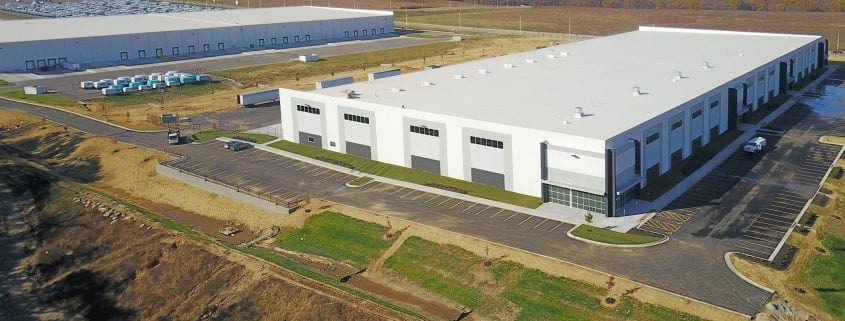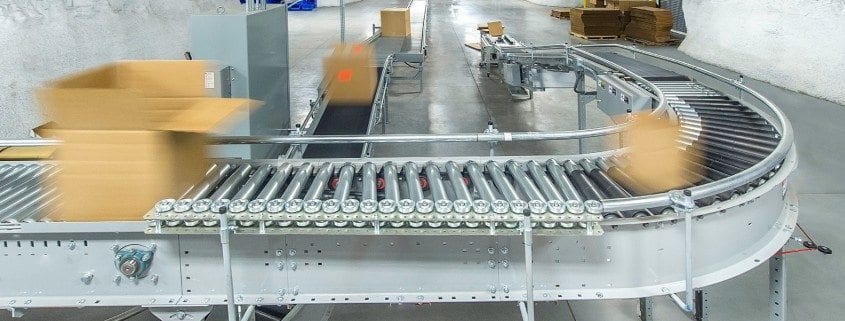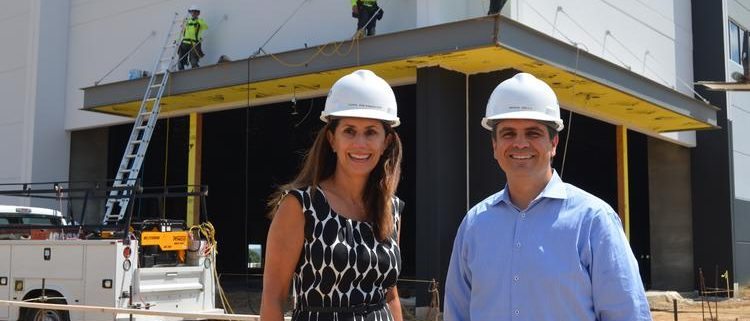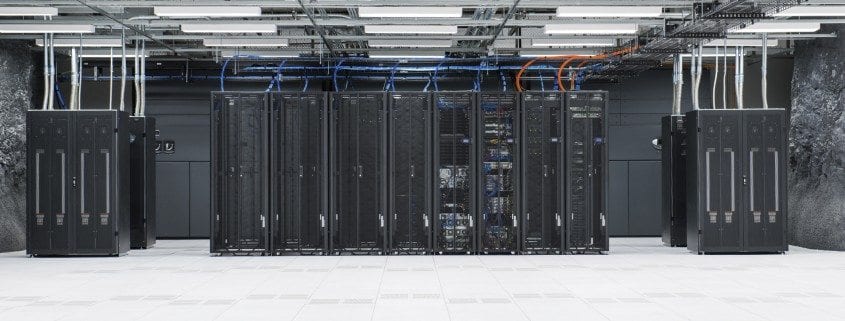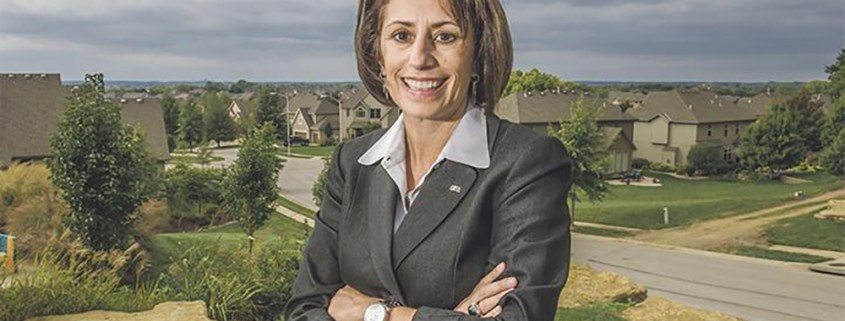Tag Archive for: ora reynolds
Incentives, industrial leasing strategy start paying off for Hunt Midwest
Rob Roberts – Kansas City Business Journal
Hunt Midwest officials are crediting incentives and a focus on smaller industrial tenants for strong leasing activity at the company’s Logistics I and II buildings in the Hunt Midwest Business Center, a 2,500-acre development at Interstate 435 and Parvin Road in Kansas City.
The following new HMBC tenants recently qualified for 25-year, 100 percent property tax abatements through an Enhanced Enterprise Zone that the business center is located within:
- American Tire Distributors Inc. opened a 108,860-square-foot regional warehouse and distribution center in HMBC Logistics II, a 200,000-square-foot, multitenant warehouse and distribution facility.
- Orbis Corp. opened a 40,777-square-foot service center for its Reusable Packaging Management division in HMBC Logistics II. The service center focuses on inventory management and cleaning of plastic reusable packaging used in the food, beverage and consumer goods supply chain.
- Spartan Motors Inc. expanded its cargo van and fleet upfit assembly operation in HMBC Logistics I to 63,169 square feet. The expansion comes less than a year after Spartan launched its all-new service line in HMBC Logistics I, which also is a 200,000-square-foot warehouse and distribution facility.
- A leading supplier to the e-commerce industry will launch a 37,888-square-foot manufacturing and fulfillment center in April at HMBC Logistics I, its first Midwest location.
“These leases validate Hunt Midwest’s decision to invest in multitenant facilities geared to tenants ranging from 40,000 square feet to over 100,000 square feet,” Hunt Midwest CEO Ora Reynolds said in a release. “Phase 5 of the Hunt Midwest Business Center includes a third 200,000-square-foot multitenant building along with room for additional buildings ranging from 450,000 to 1.2 million square feet. As businesses grow, we will have the inventory to meet their growing demands within HMBC.”
The abatements for qualified companies available through the Enhanced Enterprise Zone are based on investment and job creation.
“The EEZ is a game-changer for companies looking to locate in HMBC,” Mike Bell, Hunt Midwest’s vice president of commercial real estate, said in the release. “With the tax incentives offered, companies are benefiting greatly from substantial savings.”
With immediate proximity to FedEx and UPS hubs and a location that’s minutes from interstates 35, 29 and 70, HMBC also offers companies the ability to reach 85 percent of the U.S. market within two days while benefiting from one of the Midwest’s strongest labor pools.
“Hunt Midwest offers what we term the ‘three Ls’ of industrial real estate: location, logistics and labor,” Bell said in the release. “We are seeing a cluster effect of automotive, 3PL and e-commerce companies taking advantage of HMBC’s central location, strong workforce and direct access to public transportation.”
HMBC ultimately will include an additional 8 million square feet of master-planned, Class A warehouse and distribution space in future phases.
Serving as Hunt Midwest’s partner in the development is HSA Commercial Real Estate, a full-service firm specializing in office, industrial, retail and health care real estate leasing, management, marketing, development and financing. Besides developing and acquiring more than 50 million square feet of commercial real estate nationwide with a total value in excess of $2.5 billion, HSA Commercial Real Estate has represented owners and tenants in more than 10,000 transactions and manages a property portfolio in excess of 16 million square feet.
SubTropolis emerges as leading logistics location for animal health industry
Krista Klaus – MetroWire Media
Hunt Midwest SubTropolis is carving out a niche in the animal health logistics space, growing its veterinary industry footprint to 250,000 square feet. Over the past 12 months, three animal health companies – French veterinary pharmaceutical company Virbac, Ceva Animal Health, and IodiTech – have announced new or expanded warehouse and distribution operations in SubTropolis, which offers commissioned facilities in a naturally cool underground environment.
“SubTropolis is the total package for animal health companies and their unique requirements for product safety and climate control, providing significant operational cost efficiencies,” said Hunt Midwest President and CEO Ora Reynolds.
Virbac is currently consolidating its North American product warehousing and distribution operations in the underground business complex. According to Virbac President and CEO Paul R. Hays, the SubTropolis location will help the 8th largest veterinary pharmaceutical company better align itself within the Kansas City Animal Health Corridor, which churns out more than half of the sales generated by the global animal health industry.
“By bringing processes and people together at this Kansas City facility, we are boosting collaboration and efficiency within our manufacturing operations,” Hays said.
In addition, Ceva Animal Health and IodiTech Inc. both announced expansions in the Energy Star rated facility over the past year. Hunt Midwest Vice President Mike Bell attributes SubTropolis’ success in the animal health space to a “compelling value proposition” for companies that must adhere to industry product standards by maintaining strict temperature and humidity levels.
“The underground’s protective layer of limestone essentially offers ‘natural’ cooling that saves companies between 70 and 80 percent on utilities and equipment compared to a building on the surface,” Bell said. “There’s an ‘Aha Moment’ when companies fully realize how a SubTropolis location can substantially improve their bottom line.”
Ceva Animal Health is a case in point. CEO Craig Wallace says that consistent conditions and the ability to easily expand underground were two key reasons Ceva chose SubTropolis for a new North American warehouse and distribution center in 2015. Within a year, Ceva had outgrown its space and was able to quickly scale up to meet ongoing demand.
“The underground location is a great solution for Ceva’s current and future warehousing needs,” Wallace said. “As we add products and expand into new categories, we require scalable space and partners like Hunt Midwest who can accommodate our growth and evolve with us.”
Kansas City-based IodiTech Inc. opened a distribution operation in SubTropolis in 2016. The company manufactures and ships a variety of iodine derivatives – including animal feed minerals – throughout North America and the world.
“The ability to ship to up to 85 percent of the U.S. within two days was of critical importance,” IodiTech President Curtis Thomas said. “Our location in SubTropolis is the perfect complement to our nearby manufacturing facility.”
The growing collection of animal health assets within SubTropolis is creating an “industry cluster within a cluster” for Kansas City’s Animal Health Corridor, which will hold its annual Animal Health Investor Forum and Animal Health Homecoming Dinner August 28-29.
“Hunt Midwest SubTropolis is a valued strategic partner as we work on behalf of the Kansas City Area Development Council to attract global animal health companies to the Greater Kansas City region,” said Kimberly Young, president of the KC Animal Health Corridor.
Industrial Boom Sweeps Across KC
E-commerce, auto companies drive wave of spec projects.
Christina Cannon and Matt Valley – Heartland Real Estate Business
When it comes to the Kansas City industrial market, some developers have a build-it-and-they-willcome mentality.
Kansas City’s central location is attracting a number of e-commerce companies and strengthening the heavy automotive industry presence that has been a part of the city’s fabric for some time. To deal with demand and keep Kansas City on the radar, developers are ramping up construction on speculative projects.
“Tenants often don’t have time to come to town and build,” says Daniel Jensen, principal at Kessinger Hunter. “So if they come to a market like Kansas City that doesn’t have a certain kind of product available, they just keep going to the next market.”
For many tenants, however, that shouldn’t be an issue thanks to the amount of industrial space set to come on line in the near future. According to Costar, there was 5.3 million square feet of overall industrial space under construction at the end of the second quarter this year. This is on top of 2.8 million square feet of space that has already been delivered in the first half of the year.
“In the last three to four years there has been about 4.5 to 5 million square feet of new product brought on line each year and the majority of it has been getting absorbed,” says Jensen. “Everyone has gotten a whiff of fresh cookies in the air and has decided that they ought to be baking their own fresh cookies.”
Jensen notes that Kansas City is a fastpaced market, and when tenants want to set up shop, they want to do so quickly.
“People don’t want to come to the town and say, ‘we need to be up and operational in 18 months,’” says Jensen. “They want to come to town and say, ‘I need to order racks in 60 days, and I need to be operable in six months.’ That lends itself to a larger amount of spec space versus built-to-suit opportunities.”
Logistics Park continues streak
Leading the pack in speculative construction are NorthPoint Development and BNSF Railway with their 1,700-acre intermodal Logistics Park Kansas City. The 548,333-square-foot Inland Port XV came on line during the second quarter, and the duo has two more buildings totaling 1.5 million square feet to be delivered by the end of the third quarter.
“Logistics Park Kansas City is by and far the largest producer of spec space in the market and has been for the last several years, and that has everyone’s attention,” says Jensen. “They’ve been successful thus far getting deals done and absorbed, but are they going to be able to continue that pace? We just don’t know. Time will tell.”
Experts attribute some of the industrial park’s success to a shift in how companies are shipping goods.
“It used to be if a company was going to have three distribution centers they would have one on the West Coast, one on the East Coast and one in the Midwest. If they put one in the Midwest they generally went to Chicago or Dallas, somewhere with a larger population base,” says Jensen. “Now, we’re seeing the significance of Kansas City. You can get to about 90 percent of the population of the continental United States within two days by truck.”
Logistics Park Kansas City is the largest intermodal facility in the United States in terms of tonnage that passes through via rail, and it is the third largest trucking facility in the country.
Distribution hubs are becoming more important to e-commerce than population hubs, according to Mike Bell, vice president and general manager of commercial real estate for Hunt Midwest.
“I think initially when e-commerce was taking off you were seeing a lot of the distribution centers focused on the population density centers,” says Bell. “Now people are saying, ‘we’re going to locate in an area where we can touch the most amount of the country.’”
Shipping hubs in demand
Proximity to the major hubs of shipping companies is also an important factor for many industrial tenants in the area, says Bell. For this reason, the southwest corner and the northeast corner of Kansas City are seeing the brunt of construction and lease activity.
“Part of what we see is that tenants are locating in centers where they’re near FedEx and UPS,” says Bell. “In the northeast part of Kansas City we are near both FedEx and UPS, and are within 20 minutes of the airport. If somebody needs next-day shipping, we’re the last stop. These e-commerce companies can take an order from somebody at 7 or 8 p.m. and still get it shipped out the next morning.”
According to CoStar, of the 5.3 million square feet of industrial space under construction at the end of the second quarter, 4 million of that is in South Johnson County. The North of the River submarket welcomed over 900,000 square feet of the of 2.8 million square feet that was delivered to the Kansas City industrial market by mid-year.
Ford Transit provides a boost
E-commerce companies aren’t the only ones fighting for space in the industrial landscape. Similar to how Internet giants want to be near shipping companies, automotive suppliers and upfitters want to be near Ford Motor Co. and General Motors.
Roughly five years ago, Ford made the decision to transition its Econoline van model to the Transit van model, and locate that manufacturing operation in Kansas City. The new Transit vans can be upfitted to serve as contractor vehicles, shuttle buses or even ambulances, and every one is manufactured in Kansas City.
“When Ford made that choice it was a very monumental decision in Kansas City because the state of Missouri has since passed legislation to give automotive companies and other advanced manufacturing companies significant incentives,” says Bell. “That has propelled a lot of companies to come to Kansas City.”
Companies relocating facilities in Kansas City to become part of the automotive fabric include many manufacturers, suppliers and upfitters.
“Every time Ford or GM retools, it creates a feeding frenzy,” says Jensen. “Tenants that need facilities come racing to town just to be close to GM and Ford.”
One space that these support companies love to flock to is SubTropolis, the world’s largest underground business park. Hunt Midwest developed the park, which contains 6 million square feet of leased space and the ability to expand by another 8 million square feet. A surface business park providing even more options complements SubTropolis.
“We offer a unique perspective,” says Bell. “We are developing 2,500 acres of land on the surface and then below it we are developing virtually the same footprint.”
In addition to Ford, tenants catering to automotive industry that lease space in SubTropolis include Knapheide Manufacturing Co., Adrian Steel, Ground Effects and Leggett & Platt Commercial Vehicle Products, among others. So many upfitters are occupying space in the industrial cave that SubTropolis has even coined the moniker “Automotive Alley.”
“The temperature is constant, the humidity is constant,” says Bell. “For Ford to manufacture the Transit or the Ford F150, SubTropolis allows them to maintain a high level of quality and standards.”
SubTropolis does data
With tenants occupying anywhere from 10,000 square feet to 500,000 square feet, SubTropolis doesn’t just accommodate automotive companies. A data center opened in 2014 is bringing the industrial market full circle by attracting e-commerce users.
“We found having a data center relates closely to our e-commerce customers, because our e-commerce tenants need higher speed Internet connectivity,” says Bell. “With our data center and the fiber carriers that we have, we are able to connect our tenants with that.”
Bell notes that for e-commerce companies to survive they need both the logistics of being near shipping companies like FedEx and UPS and also bandwidth and connectivity, both amenities SubTropolis can provide.
“I see the data center as the cash register of e-commerce,” says Bell. “Somewhere there is a data center that’s running all the servers to allow e-commerce to flourish.” But not only can having a data center in the same area save on delivery speeds, it also adds a layer of security.
“That’s a big advantage,” continues Bell. “From a security standpoint, we are able to control all of our entrances, and because of our government tenants, we are required to have a high level of security.”
LightEdge Solutions, a cloud service provider, colocation and consulting company, was the first tenant at the 400,000-square-foot SubTropolis Technology Center and employees 200 people in the underground, hightech labyrinth.
What’s next?
Professionals immersed in the Kansas City industrial market agree about one thing — the market is booming. But for how long?
“Driving around SubTropolis and our Hunt Midwest Business Center, I’m seeing all of these ‘help wanted’ and ‘now hiring’ signs,” says Bell. “That to me sends the sign that the tenants are productive, their businesses are growing and they have a need.”
Jensen believes that all of this activity may be a new baseline, though the industry should prepare for the regular ups and downs within this framework.
“There most definitely is a cycle and even the new norm is going to have its downturn and its upturn. Larger users are finding Kansas City attractive and want to be here for various reasons, but without a doubt the feeding frenzy will slow at some point, and people will call an end to that cycle.” says Jensen.
“We’re playing musical chairs, and the music is going to stop and there’s going to be a few folks without seats. But having said that, I think the industrial market — the user market — is healthy.”
Auto, e-commerce demand fuel Hunt Midwest Business Center expansion
Rob Roberts – Kansas City Business Journal
By the time Hunt Midwest completes HMBC Logistics I next month, the new 200,000-square-foot Class A industrial building in the Hunt Midwest Business Center may well be leased up, said Ora Reynolds, the Kansas City-based development firm’s CEO.
Hunt Midwest is currently in the final stages of negotiations with three tenants that would fill the building, which was started last year on a speculative basis, meaning before any tenants were signed.
Once that happens, Reynolds said, Hunt Midwest will start on one of the other two 200,000-square-foot specs planned for adjacent sites in the surface business park located near Parvin Road and Interstate 435 in Clay County — just a mile and a half away from the Ford Kansas City Assembly Plant and right above the world’s largest underground business park, Hunt Midwest’s SubTropolis.
According to Reynolds, the trio of 200,000-square-feet buildings is designed to fill a niche in the market for tenants needing 40,000 to 50,000 square feet of Class A industrial space with features such as 32-foot clear height, multiple dock doors (HMBC Logistics I’s current 20 doors can be tripled to meet tenant demand) and 60-foot deep bays that allow indoor staging for 53-foot trailers. Read more…
States competing for data centers extend $1.5B in tax breaks
David Lieb – Associated Press
The former limestone mine seemed perfect for a large computer data center. The air was cool. The rock walls provided a defense against natural disasters. And the tunnels bored into a Kansas City hillside had access to abundant electricity and fiber-optic cables.
But the mine lacked something important: tax breaks. Without them, several companies chose instead to locate their data centers in neighboring Kansas. At least one major project opted for North Carolina.
“There were people who wouldn’t even come and look,” said Ora Reynolds, president and chief executive of Hunt Midwest Enterprises Inc., which has been marketing its SubTropolis caves. Financial incentives, she learned, were “absolutely crucial.”
Similar competitions for business are playing out across the country as states increasingly offer lucrative tax breaks to attract the data centers that function as the brains of the Internet. An Associated Press analysis of state revenue and economic-development records shows that government officials extended nearly $1.5 billion in tax incentives to hundreds of data-center projects nationwide during the past decade.
The actual cost to taxpayers is probably much higher because some states refused to disclose the amount of taxes they waived, citing confidentiality laws. In many cases, cities and counties sweetened the incentives by forgiving millions more in local taxes.
The benefits are debatable. Although they cost hundreds of millions of dollars to build and equip, the centers employ relatively few workers. That means they produce little in the way of new income taxes but could provide a surge in property and sales taxes — if governments don’t waive those taxes, which many do.
Some officials doubt the tax breaks are worth it because they typically benefit a single community while depriving the state budget of money that might otherwise help schools, lower the cost of college tuition or pay for roads and other infrastructure. Go to AP.org for more…
Hunt Midwest announces 126-acre industrial park expansion
Rob Roberts – Kansas City Business Journal
Responding to growing demand in the automotive supply, e-commerce and data center markets, Hunt Midwest has completed a 126-acre surface business park expansion.
The Hunt Midwest Business Center now can accommodate as much as 2 million square feet of new Class A warehouse and distribution space, the firm said in a release.
“HMBC is located in Clay County just south of Ford’s Claycomo Assembly Plant and adjacent to both the Norfolk Southern intermodal facility and Kansas City’s FedEx Ground hub,” Hunt Midwest CEO Ora Reynolds said in the release. “This makes HMBC an ideal location for e-commerce fulfillment centers, automotive suppliers and up-fitters.
“With direct access to I-435, companies locating in HMBC can ship to 85 percent of the United States within two days. The availability of multiple fiber carriers and diverse sources of power also make this a great location for data centers.”
Buildings planned in the business park’s new phase are designed for single-tenant and multitenant users and range in size from 200,000 to 875,000 square feet. One of the buildings, including 200,000 square feet, will be built on a speculative basis, meaning before tenants are lined up.
“With buildings divisible to as small as 50,000 square feet, Hunt Midwest Business Center will serve an unmet tenant demand in the industrial market,” Reynolds said in the release, adding that Hunt Midwest will offer tenants land purchase, build-to-suit and lease options. Go to KCBJ.com for more…
Power 100: Ora Reynolds – President & CEO, Hunt Midwest
Kansas City Business Journal
Ora Reynolds and Hunt Midwest have been on a roll. Ford Motor Co.’s billion-dollar investment in its Kansas City Assembly Plant has also helped fill “Automotive Alley” at Hunt Midwest’s Subtropolis. Meanwhile, the company’s residential operation has benefited from housing’s bounce-back and the growing need for senior housing.
Reynolds has worked to build up her executive team after a record 2014. That should be a help to an executive who already put in huge efforts with area development organizations and (successfully) lobbying Missouri to offer incentives for data centers. Go to KCBJ.com for more…
